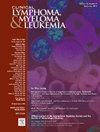异常无痛CML: 10年酪氨酸激酶抑制剂治疗后没有完全的细胞遗传学反应。
IF 2.7
4区 医学
Q2 HEMATOLOGY
引用次数: 0
摘要
背景:采用BCR::ABL1酪氨酸激酶抑制剂(TKI)治疗,大多数慢性粒细胞白血病(CML-CP)患者在治疗6个月内可达到完全细胞遗传学应答(CCyR)。然而,没有研究调查未达到CCyR但经长期TKI治疗后病情保持稳定的患者。在这里,我们调查了30例CML-CP患者,他们在TKI治疗期间没有达到CCyR,但至少10年没有发生母细胞进展。材料和方法:被诊断为CML-CP或加速期的患者接受了至少10年的TKI治疗,没有达到CCyR,但在治疗期间至少连续10年没有发生成母细胞进展。结果:在TKI启动时,骨髓中中位细胞计数为2%。在TKI治疗期间,16例患者出现额外的染色体异常(ACAs)。最常见的ACAs是+Ph (n = 9)和+8 (n = 8),大多数是短暂的,而高风险的ACAs不常见(n = 3)。20例患者中检测到BCR::ABL1激酶结构域突变,其中12例为单突变,多为短暂性突变,8例为多突变,多为持续性跨TKI治疗。中位数为4个TKI线后,最佳缓解包括完全血液学缓解(CHR) (n = 15)、轻微细胞遗传学缓解(n = 2)、部分细胞遗传学缓解(n = 10)和超过10年无CCyR期间的主要分子缓解(n = 3)。在15例获得比CHR更好的反应的患者中,14例最终失去了反应。在TKI开始后的中位随访245个月后,6名患者在中位随访165个月后进入blast期。结论:尽管没有达到CCyR,该队列中的大多数患者保持了长期稳定的疾病。通过仔细的监测和个体化的TKI治疗,一些不选择同种异体干细胞移植的非ccyr应答者仍然可以实现长期生存。本文章由计算机程序翻译,如有差异,请以英文原文为准。
Unusually Indolent CML: Absence of Complete Cytogenetic Response after 10 Years of Tyrosine Kinase Inhibitor Therapy
Background
With BCR::ABL1 tyrosine kinase inhibitor (TKI) therapy, most patients with chronic-phase chronic myeloid leukemia (CML-CP) can achieve complete cytogenetic response (CCyR) within 6 months of therapy. However, no studies have investigated patients who do not achieve CCyR yet maintains stable disease on long-term TKI treatment. Here we investigated 30 CML-CP patients who did not achieve CCyR but remained free of blastic progression for at least 10-year while on TKI therapy.
Materials and Methods
Patients diagnosed with CML-CP or accelerated phase who received at least 10 years of TKI treatment, did not achieve CCyR, yet remained free of blastic progression for a minimum of 10 consecutive years during treatment, were included.
Results
At TKI initiation, the median blast count in the bone marrow was 2%. During TKI therapy, 16 patients had additional chromosomal abnormalities (ACAs). The most common ACAs were +Ph (n = 9) and +8 (n = 8), mostly transient, while high-risk ACAs were less common (n = 3). BCR::ABL1 kinase domain mutations were detected in 20 patients, 12 patients having a single mutation, mostly transient, and 8 having multiple mutations, which were mostly persistent cross TKI therapies. After a median of 4 TKI lines, the best responses included complete hematologic response (CHR) (n = 15), minor cytogenetic response (n = 2), partial cytogenetic response (n = 10), and major molecular response beyond the 10-year period without CCyR (n = 3). Among 15 patients who achieved a response better than CHR, 14 eventually lost their response. After a median follow-up of 245 months from TKI initiation, 6 patients progressed to blast phase after a median of 165 months.
Conclusion
Despite not achieving CCyR, most patients in this cohort maintained long-term stable disease. With careful monitoring and individualized TKI treatment, long-term survival may still be achievable in some non-CCyR responders who do not opt for allogenic stem cell transplantation.
求助全文
通过发布文献求助,成功后即可免费获取论文全文。
去求助
来源期刊

Clinical Lymphoma, Myeloma & Leukemia
ONCOLOGY-HEMATOLOGY
CiteScore
2.70
自引率
3.70%
发文量
1606
审稿时长
26 days
期刊介绍:
Clinical Lymphoma, Myeloma & Leukemia is a peer-reviewed monthly journal that publishes original articles describing various aspects of clinical and translational research of lymphoma, myeloma and leukemia. Clinical Lymphoma, Myeloma & Leukemia is devoted to articles on detection, diagnosis, prevention, and treatment of lymphoma, myeloma, leukemia and related disorders including macroglobulinemia, amyloidosis, and plasma-cell dyscrasias. The main emphasis is on recent scientific developments in all areas related to lymphoma, myeloma and leukemia. Specific areas of interest include clinical research and mechanistic approaches; drug sensitivity and resistance; gene and antisense therapy; pathology, markers, and prognostic indicators; chemoprevention strategies; multimodality therapy; and integration of various approaches.
 求助内容:
求助内容: 应助结果提醒方式:
应助结果提醒方式:


